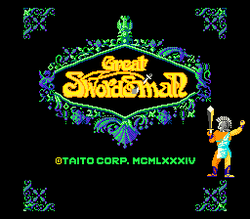Great Swordsman
Great Swordsman (グレートソードマン) is a 1984 fighting arcade game developed by Allumer and published by Taito. In 2005, it was later included in Taito Legends.
 Title screen of Great Swordsman. | |
| Developer(s) | Allumer |
|---|---|
| Publisher(s) | Taito |
| Platform(s) | Arcade |
| Release | 1984 |
| Genre(s) | 2D Versus Fighting |
| Mode(s) | Up to 2 players simultaneously |
Gameplay
In Great Swordsman, one or two players can play while taking turns. Players control with two-way joystick and three buttons with different hit levels. Each for creating different level attacks. Like in Data East's Karate Champ, buttons must be held. If they are released, the players' characters will revert to their standing animation. Moves can be defended against by intercepting the players' opponents' weapons with the players'.
The object of the game is to land a hit on the opponent or push him/her off the mat to score a point. There are fifteen levels with three different modes. The first three are fencing, the next five are kendo, and the final seven are gladiator-based. After clearing all levels in one mode, the "VICTORY SCORE" will be added to the players' scores, even if any of them was tied with their opponents at the end. After fifteen levels are completed, the players start over in a higher difficulty setting and repeat after the next fifteen levels are also cleared. There are also bonus levels where players must deflect arrows to score extra points.
Reception
In Japan, Game Machine listed Great Swordsman on their September 1, 1984 issue as being the most-successful table arcade unit of the year.[1]
Related works
- Musashi no Ken – Tadaima Shugyō Chu - A Taito-published Family Computer title based on the manga/anime series Musashi no Ken. Great Swordsman was originally planned to be ported to the Family Computer, but was canceled. Instead, everything seen in its kendo mode was included with a platformer.
- Gladiator - Another arcade game developed by Allumer and published by Taito, that utilizes the fighting system of Great Swordsman.
- Blandia - Sequel to Gladiator.
Reception
- "Game Machine's Best Hit Games 25 - テーブル型TVゲーム機 (Table Videos)". Game Machine (in Japanese). No. 243. Amusement Press, Inc. 1 September 1984. p. 29.
External links
- Great Swordsman at the Killer List of Videogames
- Great Swordsman at arcade-history.com